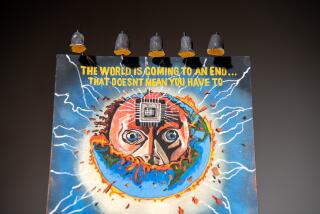Review: Ulrich Wüst at Christopher Grimes Gallery: A portrait of obsolescence
- Share via
Barely a single living soul is glimpsed in 48 black-and-white urban photographs from the late 1970s and early 1980s by Berlin-based Ulrich Wüst. When people are there, they’re typically obscured behind the windshield of a car on an otherwise empty city street, hidden within a dark sidewalk shadow in the composition’s margins or far off in the distance, back near the vanishing point of a brick roadway lined with shabby buildings.
In a picture of a wintry city park, the only person playing is a static sculpture of an athlete with a ball, frozen in mid-leap. Call these photographs civic portraits without the civitas.
At Christopher Grimes Gallery, Wüst’s debut in an American gallery (he has shown at the MIT Museum in Cambridge, Mass.) is a somewhat mixed affair. The cityscapes are at once novel and familiar.
Trained as a city planner in Communist East Germany, Wüst began to use a camera in 1972 to record and study urban development in a straightforward, inexpressive manner. One result is a visual format that recalls long-established artistic motifs by German forebears like Bernd and Hilla Becher, Albert Renger-Patzsch and August Sander from earlier in the 20th century, as well as American photographers like Lewis Baltz, Judy Fiskin and others related to the New Topographic movement of the 1970s and after.
Wüst pictures the city’s putative soullessness before the fall of the Berlin Wall. Patterns of construction that underlie a superficial urban diversity often look strange — alienating, mostly, in these emotionally blank photographs.
More compelling is a group of seven more recent color pictures (they date from 1990, as Communism was in collapse) selected from a larger compendium. They might be called portraits of domestic objects — a desk lamp, a spice grinder, a thermos, a plaid purse, etc. The lamp is tattered, the grinder filthy, the thermos cracked, while the handbag’s handle is incongruously tangled up in rubber bands.
Here to be remembered, however dimly, and not forgotten, each is placed in profile on the same baby-blue checkered tablecloth before a baby-pink floral-patterned wall, like portraits uniformly chronicled in an authorized yearbook or a catalog of damaged goods. Collectively titled “Nachlass” (“Estate”), they are what is left behind when an entire society dies.
Christopher Grimes Gallery, 916 Colorado Ave., Santa Monica, (310) 587-3373, through June 17. Closed Sun. and Mon. www.cgrimes.com
christopher.knight@latimes.com
ALSO
Review: New Marciano foundation proves the potential and the pitfalls of a vanity art museum
Review: At Shoshana Wayne Gallery, a cast of thousands roams an indoor desert
LACMA’s latest additions: Acquisitions to the permanent collection, in pictures
More to Read
The biggest entertainment stories
Get our big stories about Hollywood, film, television, music, arts, culture and more right in your inbox as soon as they publish.
You may occasionally receive promotional content from the Los Angeles Times.











